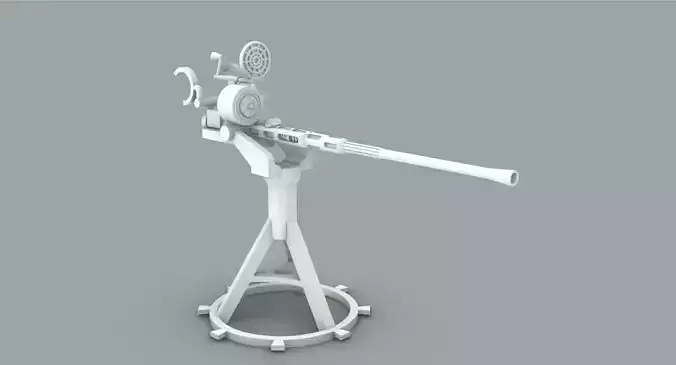1/15
3D Model of Oerlikon 40mm, made for 3D Model of HMCS Crescent.
Model is ready to be used in 3D Printing, Design, CNC..
Notes:
All models are preprinted in order to get highest quality possible.
Model is simplified for printing.
Dimensions
Length: 26.92mm
Width: 11.35mm
Height: 17.70mm
Includes OBJ and STL file.
About
The Oerlikon 20 mm cannon is a series of autocannons, based on an original German Becker Type M2 20 mm cannon design that appeared very early in World War I. It was widely produced by Oerlikon Contraves and others, with various models employed by both Allied and Axis forces during World War II. Many versions of the cannon are still used today.In 1927 the Oerlikon S was added to the existing product line. This fired a still larger cartridge (20x110RB) to achieve a muzzle velocity of 830 m/s (versus 490 m/s for the original Becker 20x70RB gun), at the cost of increased weight and a reduced rate of fire (280 rpm). The purpose of this development was to improve the performance of the gun as an anti-tank and anti-aircraft weapon, which required a higher muzzle velocity. An improved version known as the 1S followed in 1930. Three sizes of gun with their different ammunition and barrel length, but very similar mechanisms, continued to be developed in parallel. In 1930 Oerlikon reconsidered the application of its gun in aircraft and introduced the AF and AL, designed to be used in flexible mounts, i.e. manually aimed by a gunner. The 15-round box magazine used by earlier versions of the gun was replaced by drum magazine holding 15 or 30 rounds. In 1935 it made an important step by introducing a series of guns designed to be mounted in or on the wings of fighter aircraft. Designated with FF for Flügelfest meaning 'wing-mounted', these weapons were again available in the three sizes, with designations FF, FFL and FFS. The FF fired a slightly larger cartridge than the AF, 20x72RB, but the major improvement in these weapons was a significant increase in rate of fire. The FF weighed 24 kg and achieved a muzzle velocity of 550 to 600 m/s with a rate of fire of 520 rpm. The FFL of 30 kg fired a projectile at a muzzle velocity of 675 m/s with a rate of fire of 500 rpm. And the FFS, which weighed 39 kg, delivered a high muzzle velocity of 830 m/s at a rate of 470 rpm.[4] Apart from changes to the design of the guns for wing-mounting and remote control, larger drums were introduced as it would not be possible to exchange magazines in flight. For the FF series 45, 60, 75 and 100 (and a rarely used 150) drum magazines were available, but most users chose the 30 or 60-round drum. The 1930s were a period of global re-armament, and a number of foreign firms took licenses for the Oerlikon family of aircraft cannon. In France, Hispano-Suiza manufactured development of the FFS as the Hispano-Suiza HS.7 and Hispano-Suiza HS.9, for installation between the cylinder banks of its V-12 engines. In Germany, Ikaria further developed the FF gun as the MG FF, firing 20x80RB ammunition. And the Imperial Japanese Navy, after evaluating all three guns, ordered developments of the FF and FFL as the Type 99-1 and Type 99-2. The incorporation of the improvements of the FFS in a new anti-aircraft gun produced, in 1938, the Oerlikon SS. Oerlikon realized further improvements in rate of fire on the 1SS of 1942, and the 2SS of 1945 which achieved 650 rpm. However, it was the original SS gun which was widely adopted as anti-aircraft gun, being especially widely used by Allied navies during World War II. This gun used a 400-grain (26-gram) charge of IMR 4831 smokeless powder to propel a 2,000-grain (130-gram) projectile at 2,800 feet (850 meters) per second.[5]
REVIEWS & COMMENTS
accuracy, and usability.















